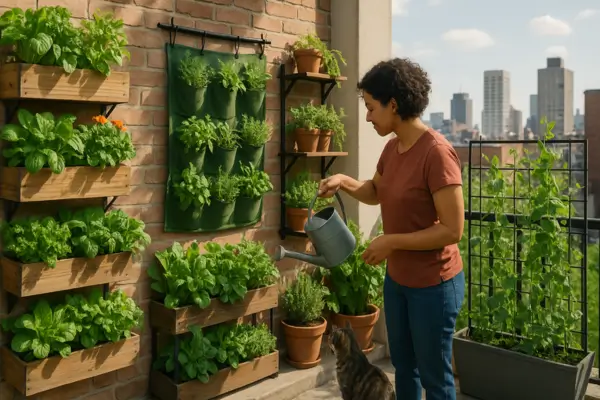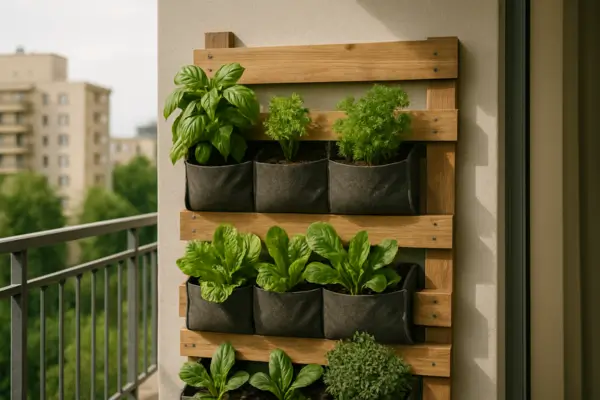Living in a bustling city doesn’t mean you have to give up on your dream of growing fresh herbs, vegetables, or flowers. Urban gardening comes with its own set of challenges—limited square footage, cramped balconies, and sometimes, barely enough sunlight. But what if you could turn those blank walls, railings, or even tiny corners into a thriving green oasis?
Enter vertical gardening—a game-changing approach for urban homesteaders who want to maximize every inch of space. By growing up instead of out, you can cultivate a lush, productive garden without needing a sprawling backyard. Whether you’re working with a small balcony, a sunny windowsill, or a compact patio, vertical gardening unlocks new possibilities for urban growers.
In this article, we’ll explore the benefits of vertical gardening, the best plants to grow vertically, and creative DIY systems to help you get started. By the end, you’ll have the inspiration and practical tips to transform even the tiniest urban space into a flourishing garden. Let’s dig in!
What is Vertical Gardening?
When space is limited, the only direction left to grow is up—and that’s exactly what vertical gardening is all about. Unlike traditional gardening, which spreads plants across horizontal beds, vertical gardening uses structures and containers to grow plants upward, making the most of unused vertical space.
The Concept: Growing Up, Not Out
Vertical gardening involves training or arranging plants to climb, hang, or stack in layers rather than spreading across the ground. This method is perfect for urban homesteaders who want to cultivate herbs, vegetables, flowers, and even small fruits without needing a large plot of land.
Different Forms of Vertical Gardening
There are countless ways to implement vertical gardening, depending on your space, budget, and creativity. Some popular systems include:
- Trellises & Arbors – Ideal for vining plants like tomatoes, cucumbers, and beans.
- Wall-Mounted Planters & Green Walls – Modular panels or pocket planters that turn blank walls into living gardens.
- Hanging Baskets & Macramé Planters – Perfect for trailing herbs (like mint or oregano) and ornamental flowers.
- Stacked Pots & Tiered Planters – Space-saving designs that let you grow multiple plants in a compact footprint.
- Repurposed Structures – Old pallets, ladders, shoe organizers, or even PVC pipes can be transformed into vertical gardens.
Why It’s Perfect for Urban Settings
Urban environments often lack ground space, but they’re full of untapped vertical potential—balcony railings, fences, walls, and windowsills. Vertical gardening solves key urban challenges by:
✔ Maximizing limited space – Grow more in the same square footage.
✔ Improving accessibility – No bending over; plants are at eye level for easy care.
✔ Enhancing aesthetics – Adds greenery to concrete-heavy surroundings.
✔ Reducing pests & diseases – Elevation helps with airflow and keeps plants away from soil-borne pests.
Whether you’re working with a tiny apartment balcony or a shared rooftop, vertical gardening lets you rethink space and turn any urban nook into a productive garden. 🌿
Benefits of Vertical Gardening for Urban Homesteaders
For city dwellers craving homegrown food and flowers but struggling with limited square footage, vertical gardening isn’t just a space-saver—it’s a game-changer. Here’s why this upward-growing approach delivers exceptional advantages for urban homesteaders:
✔ Space Efficiency: Grow More in Less Area
Vertical gardens multiply your growing potential by utilizing unused vertical real estate—walls, railings, and even ceilings. While traditional gardens spread outward, vertical systems let you:
- Grow 3-5x more plants in the same footprint
- Utilize narrow spaces (like balcony corners or between windows)
- Combine edibles and ornamentals in layered designs
✔ Improved Airflow & Sunlight Exposure
Elevated plants enjoy better:
- Air circulation that reduces fungal diseases (like powdery mildew)
- Sun penetration as leaves aren’t shaded by neighboring plants
- Even growth since vines naturally reach toward light
Pro Tip: Rotate wall-mounted planters occasionally to ensure all sides get sunlight.
✔ Aesthetic Appeal: Green Up Your Urban Jungle
Vertical gardens transform sterile urban spaces into living art installations. Benefits include:
- Softening concrete walls with cascading foliage
- Creating privacy screens with tall plants like bamboo or climbing beans
- Adding color bursts with flowering vines (nasturtiums, morning glories)
✔ Accessibility: Gardening Without the Strain
No more kneeling or bending! Vertical setups offer:
- Waist-high harvesting of herbs, greens, and berries
- Easier pest inspection at eye level
- Simplified watering with drip systems or self-watering planters
Ideal for: Seniors, wheelchair users, or anyone with limited mobility.
✔ Reduced Pest Problems
Elevating plants above ground level helps deter:
- Slugs, snails, and soil-dwelling insects
- Rodents that can’t climb smooth surfaces
- Some fungal issues caused by soil splashback
Bonus: Companion planting (like basil with tomatoes) works beautifully in vertical arrangements to repel pests naturally.
The Takeaway
Vertical gardening solves multiple urban challenges at once—saving space while boosting plant health, accessibility, and beauty. Whether you’re growing salad greens on a fire escape or strawberries on a trellis, going vertical means harvesting abundance from the unlikeliest places.
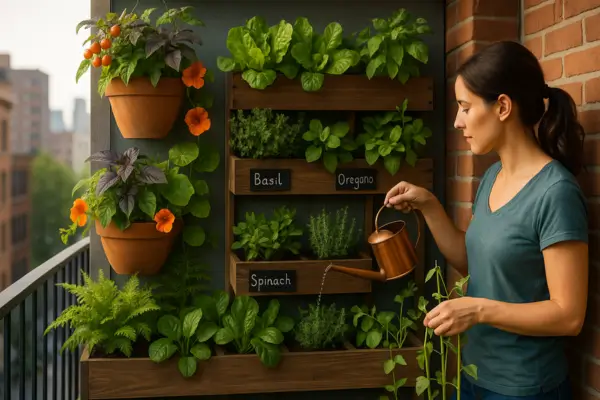
Best Plants for Vertical Gardens
Not all plants thrive in vertical setups, but many varieties actually grow better when given room to climb or cascade. Whether you’re craving fresh herbs, crisp greens, or vibrant blooms, these top-performing vertical garden plants will help you maximize your urban harvest.
🌿 Herbs: Flavor at Eye Level
Compact and fast-growing, herbs are perfect for vertical planters, hanging baskets, or wall pockets:
- Basil – Thrives in sunny spots; pinch leaves to encourage bushiness
- Mint – Grows aggressively (best contained in its own pot to prevent spreading)
- Thyme/Oregano – Drought-tolerant; ideal for vertical herb spirals
- Parsley/Cilantro – Shallow-rooted; grows well in stacked planters
Bonus: Snip herbs frequently to promote growth and prevent legginess.
🥬 Leafy Greens: Cut-and-Come-Again Convenience
Salad greens grow surprisingly well vertically, especially with these space-saving tricks:
- Lettuce (Butterhead, Romaine) – Plant in staggered wall pockets for a “living salad wall”
- Spinach/Kale – Use tiered planters; harvest outer leaves to prolong production
- Swiss Chard – Colorful stems add visual interest to vertical setups
- Arugula/Microgreens – Fast-growing; perfect for shallow trays
Tip: Grow greens in partial shade to prevent bolting in hot weather.
🌱 Vining Plants: Nature’s Vertical Champions
These climbers want to reach upward—just give them support!
- Tomatoes (Cherry/Patio varieties) – Train on trellises or hanging upside-down planters
- Cucumbers – Use A-frame trellises to save ground space
- Peas/Beans (Pole varieties) – Twine up nets or bamboo teepees
- Strawberries – Thrive in stacked pots or hanging pockets
Pro Hack: Attach soft plant ties to guide vines gently (old pantyhose strips work well).
🌸 Flowers & Ornamentals: Beauty Meets Function
Mix edibles with these eye-catching vertical-garden stars:
- Petunias/Calibrachoa – Cascade beautifully from hanging baskets
- Ferns – Add lush texture to shady vertical gardens
- Succulents (Sedum, String of Pearls) – Drought-tolerant for sunny walls
- Nasturtiums – Edible flowers that repel pests
Design Tip: Pair purple basil with pink petunias for a stunning (and edible) display.
Key Considerations for Plant Selection
- Light Requirements: Match plants to your space’s sun exposure (e.g., basil needs 6+ hours; ferns prefer shade).
- Weight Limits: Heavy plants (like mature tomatoes) need sturdy supports.
- Water Needs: Group plants with similar thirst levels (e.g., don’t pair succulents with lettuce).
By choosing the right plants, your vertical garden can be both productive and picturesque—a true urban oasis.
DIY Vertical Gardening Systems: Creative Space-Saving Solutions
Urban homesteaders don’t need fancy equipment to grow vertically—just creativity and resourcefulness! These easy DIY systems turn walls, railings, and small corners into productive gardens using affordable (or free) materials.
🛠️ Wall-Mounted Planters: Turn Blank Walls into Gardens
Pallet Gardens
- How to: Stand a clean wooden pallet upright, line the back with landscape fabric, fill with soil, and plant herbs/succulents in the slats.
- Best for: Strawberries, herbs, or cascading flowers.
Fabric Pocket Planters
- How to: Hang a shoe organizer or specialized gardening pocket panel on a sunny wall. Fill each pocket with soil and plants.
- Best for: Lettuce, spinach, or small herbs like thyme.
Tip: Use drip irrigation for easy watering (poke holes in a PVC pipe across the top).
🌿 Trellises & Arbors: Support for Climbers
Bamboo/Stick Teepees
- How to: Tie bamboo poles or branches into a cone shape; plant beans or peas at the base.
- Best for: Pole beans, cucumbers, or flowering vines.
Upcycled Ladder Trellis
- How to: Lean an old wooden ladder against a wall; train tomatoes or gourds up the rungs.
- Best for: Heavy climbers like squash or melons (ensure sturdy anchoring).
Pro Hack: Add twine between rungs for extra support.
🔄 Hanging Gardens: Elevate Your Greens
Gutter Gardens
- How to: Mount rain gutters horizontally on a fence or railing; drill drainage holes and fill with soil.
- Best for: Shallow-rooted greens (arugula, radishes) or herbs.
Soda Bottle Planters
- How to: Cut plastic bottles in half, punch holes in the caps for drainage, and hang with ropes.
- Best for: Cherry tomatoes, strawberries, or trailing flowers.
Bonus: Paint bottles for a colorful display.
⬆️ Stacked Containers: Grow Upward in Layers
Tiered Pot Towers
- How to: Stack terra-cotta pots of decreasing sizes with a rod through the centers.
- Best for: Herbs, flowers, or compact peppers.
Tower Gardens (DIY Version)
- How to: Use a 5-gallon bucket with holes drilled around the sides; plant strawberries or greens in each opening.
- Best for: High-yield edible gardens in tight spaces.
Tip: Add a central PVC pipe with holes to water all levels at once.
Choosing Your System
Consider:
- Weight capacity (avoid overloading balconies).
- Sun exposure (wall-mounted planters need at least 4–6 hours of light).
- Material durability (use UV-resistant fabrics for outdoor setups).
With these DIY systems, you can customize a vertical garden for any space—no yard required!
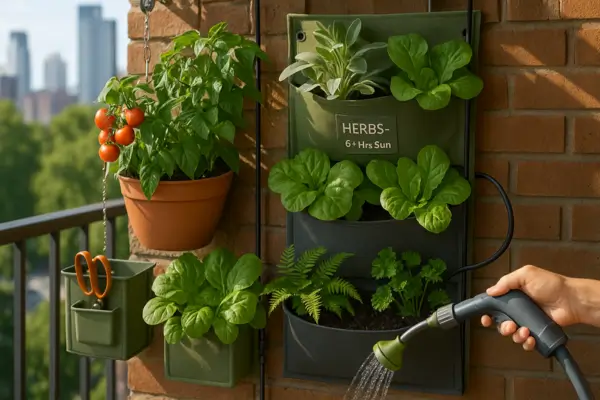
Essential Tips for Successful Vertical Gardening
Vertical gardening unlocks incredible potential for urban growers, but it requires slightly different care than traditional gardens. Follow these proven strategies to keep your vertical oasis thriving all season long.
📍 Choose the Right Location
Sunlight Matters
- 6+ hours of sun: Tomatoes, peppers, basil
- 3–6 hours: Lettuce, spinach, mint
- Shade-tolerant: Ferns, begonias, parsley
Tip: Observe light patterns for 2–3 days before installing planters. South-facing walls get the most sun.
Wind Protection
- Secure lightweight systems (like fabric pockets) to prevent tipping.
- Use windbreaks (bamboo screens, trellises) for delicate plants.
🌱 Use Quality Soil & Ensure Proper Drainage
Soil Mix Recipe for Vertical Gardens:
- 60% potting mix (lightweight)
- 30% compost (nutrient-rich)
- 10% perlite/vermiculite (for drainage)
Avoid: Garden soil (too heavy) or moisture-retentive mixes (can cause root rot).
Drainage Hacks:
- Drill extra holes in containers.
- Add a 1-inch gravel layer at the bottom of stacked planters.
- Elevate wall planters slightly to allow runoff.
💧 Smart Watering Strategies
Drip Irrigation
- Ideal for wall-mounted or tiered systems.
- Use a timer to automate watering (morning is best).
Self-Watering Systems
- Convert gutters or buckets into reservoirs with wicks.
- Add water-absorbing polymers to soil for drought-prone areas.
Warning: Vertical gardens dry out faster! Check soil moisture daily in summer.
✂️ Regular Maintenance = Long-Term Success
Pruning & Training
- Pinch back herbs to encourage bushiness.
- Guide vines onto supports with soft ties (avoid wire that can cut stems).
Fertilizing
- Use liquid seaweed/fish emulsion every 2 weeks (container plants need more nutrients).
- Top-dress with compost monthly.
Pest Patrol
- Inspect leaf undersides weekly (aphids love vertical gardens).
- Spray with neem oil or insecticidal soap at first sign of pests.
Bonus Tip: Rotate plants seasonally—swap cool-weather greens for heat-loving beans in summer.
Pro Checklist for Vertical Garden Health
✅ Weekly: Water deeply, check for pests, remove dead leaves.
✅ Monthly: Fertilize, prune overcrowded growth.
✅ Seasonally: Refresh soil, replace spent plants.
By mastering these fundamentals, your vertical garden will deliver maximum yields with minimum space—all while looking stunning.
Need troubleshooting advice for specific issues (like yellowing leaves)? Just ask! 🌿
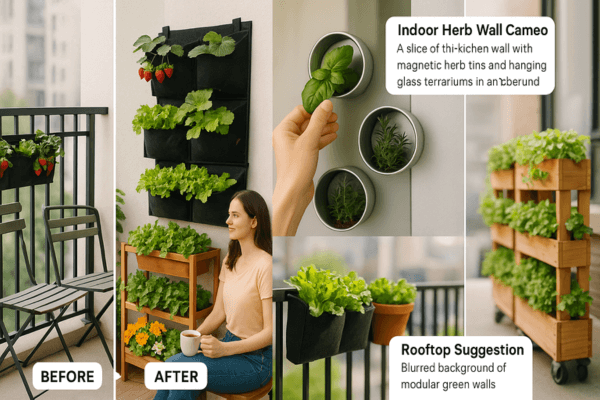
Inspiring Vertical Garden Ideas for Small Spaces
Think your tiny apartment or cramped balcony can’t support a garden? Think again! These space-smart vertical garden ideas prove you can grow food and beauty in even the most compact urban spaces.
🌿 Balcony Vertical Gardens: Sky-High Harvests
Transform your balcony railing or walls into an edible paradise:
- Hanging Pocket Gardens – Fabric planters on railings for strawberries or herbs
- Tiered Shelf Planters – Stack pots to grow lettuces, radishes, and flowers
- Rail Planters – Attach window boxes to balcony edges for instant growing space
Bonus: Use a tension rod between walls to hang lightweight planters without drilling.
🏡 Indoor Herb Walls: Fresh Flavors at Your Fingertips
Bring your kitchen to life with these ideas:
- Magnetic Spice Garden – Grow small herbs in tins on a steel backsplash
- Hanging Glass Terrariums – Perfect for delicate herbs like cilantro and parsley
- Stacked Bookshelf Garden – Use narrow shelves near windows for potted herbs
Pro Tip: Rotate pots weekly so all sides get equal light exposure.
☀️ Rooftop & Patio Setups: Urban Farming in the Sky
Maximize sunny rooftops and patios with:
- Modular Green Walls – Interlocking planters for a living privacy screen
- Pallet Planters on Wheels – Mobile gardens you can rearrange as needed
- Trellis Dividers – Grow beans or morning glories to create shaded nooks
Key Consideration: Check weight limits before installing heavy systems on rooftops.
♻️ Repurposed Materials: Eco-Friendly & Budget-Smart
Turn everyday items into ingenious planters:
- Old Ladders – Lean against walls as a rustic plant stand
- PVC Pipe Gardens – Drill planting holes in vertical pipes for strawberries
- Wine Bottle Planters – Hang upside-down with herbs trailing from the necks
- Shoe Organizers – The perfect pocket system for small-rooted plants
Creative Twist: Paint or decorate repurposed items to match your style.
Small-Space Success Secrets
- Start Small – Try one vertical system before expanding.
- Mix Function & Beauty – Pair edible plants with flowers for visual appeal.
- Go Mobile – Use casters or lightweight systems for flexible arrangements.
Whether you’re working with a sunny windowsill or a concrete patio, these ideas prove that where there’s a wall, there’s a way to grow!
Grow Up, Not Out – Your Urban Garden Awaits!
Vertical gardening isn’t just a trend—it’s a revolutionary approach for urban homesteaders to reclaim space, grow their own food, and transform sterile walls into thriving ecosystems. By now, you’ve seen how growing upward lets you:
✔ Defy limited space with creative systems like pallet gardens and hanging planters
✔ Boost plant health through better airflow, sunlight, and pest resistance
✔ Harvest with ease thanks to waist-high herbs and eye-level veggies
✔ Turn constraints into creativity by repurposing everyday items into planters
Your Next Steps
Don’t wait for the “perfect” setup—start small today!
- Try a single hanging basket of cherry tomatoes
- Convert a shoe organizer into a salad-green wall
- Propagate herbs in upcycled jars on a sunny window
Every vertical garden begins with one pot, one trellis, or one bold idea.
Join the Vertical Gardening Movement!
We’d love to see what you grow:
💬 Comment below: Share your projects or ask questions!
The sky’s the limit—literally. Happy growing! 🌿✨

